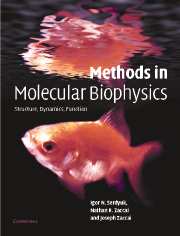Book contents
- Frontmatter
- Contents
- Foreword by D. M. Engelman
- Foreword by Pierre Joliot
- Preface
- Introduction: Molecular biophysics at the beginning of the twenty-first century: from ensemble measurements to single-molecule detection
- Part A Biological macromolecules and physical tools
- Part B Mass spectrometry
- Part C Thermodynamics
- Part D Hydrodynamics
- Part E Optical spectroscopy
- Part F Optical microscopy
- Chapter F1 Light microscopy
- Chapter F2 Atomic force microscopy
- Chapter F3 Fluorescence microscopy
- Chapter F4 Single-molecule detection
- Chapter F5 Single-molecule manipulation
- Part G X-ray and neutron diffraction
- Part H Electron diffraction
- Part I Molecular dynamics
- Part J Nuclear magnetic resonance
- References
- Index of eminent scientists
- Subject Index
- References
Chapter F1 - Light microscopy
from Part F - Optical microscopy
Published online by Cambridge University Press: 05 November 2012
- Frontmatter
- Contents
- Foreword by D. M. Engelman
- Foreword by Pierre Joliot
- Preface
- Introduction: Molecular biophysics at the beginning of the twenty-first century: from ensemble measurements to single-molecule detection
- Part A Biological macromolecules and physical tools
- Part B Mass spectrometry
- Part C Thermodynamics
- Part D Hydrodynamics
- Part E Optical spectroscopy
- Part F Optical microscopy
- Chapter F1 Light microscopy
- Chapter F2 Atomic force microscopy
- Chapter F3 Fluorescence microscopy
- Chapter F4 Single-molecule detection
- Chapter F5 Single-molecule manipulation
- Part G X-ray and neutron diffraction
- Part H Electron diffraction
- Part I Molecular dynamics
- Part J Nuclear magnetic resonance
- References
- Index of eminent scientists
- Subject Index
- References
Summary
Historical review
Light microscope
Mid-fifteenth century
The simple one-lens microscope was available at this time, with low-power magnifiers being used for the examination of insects. From these early beginnings, glass lenses of increased power were developed. A. Leeuwenhoek (1632– 1723) produced remarkable microscopes. One of them had a resolving power of 1.35 μm, which was enough for basic cytology. About the same time the basic idea for the compound microscope, in which two or more lenses are arranged in such way to form an enlarged image of an object, occurred independently to several people in the Netherlands (H. Jansen, his son Zacharias and H. Lippershey). Subsequently, compound microscopes became widely available.
1830
J. Lister published the first work in which the construction and design of achromatic microscope lenses was placed on theoretical bases. He showed how two separate achromatic lenses could be combined to act as a single lens so that the image rendered would be completely free from chromatic aberration and from distortion caused by curvature of the lenses. This discovery opened the way to the construction of high-power microscope lenses over the next 50 years. The first achromatic microscope lenses appeared in the Netherlands at about the end of the eighteenth century.
The latter part of the nineteenth century
E. Abbe was the outstanding figure in development of the microscope. Abbe placed the theory of microscopic image formation on a sound basis by emphasising the importance of the light diffracted by the object in resolving its fine details.
- Type
- Chapter
- Information
- Methods in Molecular BiophysicsStructure, Dynamics, Function, pp. 627 - 640Publisher: Cambridge University PressPrint publication year: 2007



